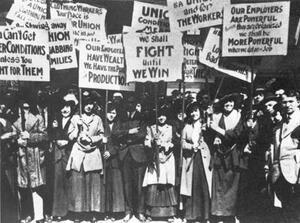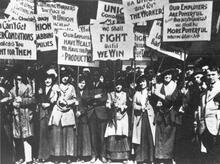Dorothy Jacobs Bellanca
Dorothy Jacobs Bellanca made huge strides for worker’s rights as a union leader and through civil service. Bellanca started working in a factory at thirteen and organized her fellow workers into the local Union Garment Workers of America at fifteen. By twenty, she led them to separate into the Amalgamated Clothing Workers of America and was one of the few female delegates at the founding convention. After serving as the only woman on the union’s General Executive Board, she was elected vice president the following year—the only woman vice president of a major trade union. In 1936, Bellanca became involved in politics, helping found the American Labor Party and making an unsuccessful run for Congress. During World War II, she was also served on various federal commissions addressing labor issues.
Early Life
The New York Times described Dorothy Jacobs Bellanca as one of America’s foremost women labor leaders. An outstanding union organizer and a captivating speaker, she was born in Zemel, Latvia, on August 10, 1894. Though she lacked formal ties to the Jewish community, many of the immigrants Bellanca organized were Jewish. The youngest of four daughters of Bernice and Henry Jacobs, she immigrated with her family to Baltimore in 1900, where her father worked as a tailor. Her mother died several years later. She attended Baltimore public schools. At age thirteen, she started work as a hand buttonhole sewer on men’s coats. After one month of unpaid training, she began ten-hour workdays, earning three dollars a week.
At age fifteen, Dorothy organized female immigrant buttonhole makers into Local 170 of the United Garment Workers of America (UGW). In 1914, she led her union from the conservative UGW to the Amalgamated Clothing Workers of America (ACWA). Bellanca promoted class solidarity, but she took particular interest in organizing women. She worked to convince men that unionizing women, a majority of the industry, benefited all workers.
Advocacy
Bellanca was one of five women (of 175 delegates) who attended the founding convention of the ACWA, where she promoted the need for a woman organizer. She became secretary of the Joint Board (the ACWA’s central body in Baltimore) on October 21, 1915, and established the Education Department, paying particular attention to the experiences of women unionists. In 1916, the ACWA recognized her skills. She was the sole female nominated to serve on the seven-member General Executive Board (GEB) and in July, at age twenty-one, became the only woman vice president of a major trade union.
She undertook a wide range of tasks for the union. In 1917, she participated in major organizing campaigns in Philadelphia and New York. The same year the ACWA appointed her as a full-time woman’s organizer. In that role, she promoted a union culture that involved members and families in activities beyond the shop. She regularly contributed to Advance, the ACWA’s paper, which began publication in English in March 1917, and included articles in both Italian and Yiddish.
She married August Bellanca, an Italian ACWA labor leader, in 1918. She won reelection to the GEB in 1918 but stepped down after she married, though remaining active in the union. During the war, she encouraged unionization among uniform makers. In 1920, the Bellancas joined a special committee to organize “runaway” shops that evaded the union by moving their facilities into economically depressed areas. During the 1920s, Bellanca emerged as one of the most powerful women trade unionists. In 1922, August Bellanca became ill and his doctor recommended rest. The couple traveled abroad, because they knew they would need to leave the country in order to avoid union demands. Bellanca believed her husband’s contributions to the ACWA were unique, and she could be of greatest assistance to him, and thus the union, by leaving her own position and caring for her husband.
Bellanca favored the creation of a separate Women’s Department within the ACWA, which the GEB invited Bellanca to direct upon its establishment in July 1924. She supported the good of the organization over individual interests. Consequently, she recommended disbanding the Women’s Department after learning that Baltimore men resented it. The Women’s Department dissolved in 1926. Though Bellanca still encouraged separate organizing activities targeting women, she opposed reestablishment of the Women’s Department in 1928.
During 1933–1934, unions experienced a revival thanks to the New Deal. Bellanca set to work organizing women in rural areas of Pennsylvania, New Jersey, New York, and Connecticut. Bellanca was also involved in politics and helped found the American Labor Party (ALP) in 1936. Despite reservations some unionists had toward the Democratic Party, Bellanca supported Franklin D. Roosevelt’s reelection campaign, because he was most supportive of workers’ interests. In 1938, Frances Perkins, secretary of labor, asked Bellanca to serve on the Maternal and Child Welfare Committee. The same year, in an unusual move for women, Bellanca ran for Congress for Brooklyn’s Eighth Congressional District, gaining the support of the ALP, Republican Party, City Fusion Party, Progressive Party, and Fiorello La Guardia. She supported federal housing programs, national health care, wages and hours law, and civil rights legislation. Incumbent Donald J. O’Toole, who won (133,998 to 118,000), sought to discredit Bellanca, noting that she lived in Manhattan, not Brooklyn, was not Italian, and had abandoned Judaism by marrying a Catholic. Soon after the start of World War II, Bellanca joined the Women’s Policy Committee of the War Manpower Commission, concerned with incorporating women into war industries.
Recognition and Legacy
Throughout the 1940s, Bellanca served on numerous city, state, and federal committees. She was an adviser to the Department of Labor Committee on Women in Defense Work (1940). She advocated protective legislation and opposed the Equal Rights Amendment, but supported equal treatment of trade union women. She served on the Labor Advisory Committee of the Department of Labor, as labor adviser to the International Labor Organization Conference, and on the New York Defense Council on Discrimination in Employment (1941). Other service included membership on a state commission on problems of women in wartime (1942); the New York State War Council Committee on Discrimination (1943), from which she and seven others resigned when Governor Thomas E. Dewey refused to support antidiscrimination legislation; and a committee to promote racial harmony in New York City. In 1940 and 1944, she was elected state vice-chair of the ALP. Bellanca was also active in the Consumers’ League of New York and the Women’s Trade Union League. The Women’s City Club recognized Bellanca in 1945 as one of thirty women who gave outstanding service to New York.
Bellanca developed multiple myeloma, tumors of the bone marrow, a painful and debilitating disease. The ACWA honored her at a special luncheon in 1944. She had hoped to attend the ACWA’s first postwar convention in 1946, but was too weak. She died on August 16, 1946, just after her fifty-second birthday.
AJYB 49:608.
Asher, Nina Lynn. “Dorothy Jacobs Bellanca: Feminist Trade Unionist: 1894–1946.” Ph.D. diss., State University of New York, Binghamton, 1982.
Asher, Nina. “Dorothy Jacobs Bellanca: Women Clothing Workers and the Runaway Shops.” In A Needle, A Bobbin, A Strike: Women Needleworkers in America, edited by Joan Jensen and Sue Davidson (1984).
Bellanca, Dorothy Jacobs. Papers. Martin P. Catherwood Library, New York State School of Industrial and Labor Relations, Cornell University, Ithaca, New York.
DAB 4.
“Dorothy Bellanca—A Tribute.” Life and Labor Bulletin 75, no. 3 (1946): 3.
Marcus, Jacob. United States Jewry: 1776–1985. Vol. 4 (1993): 239–240.
Markowitz, Ruth Jacknow. “Dorothy Jacobs Bellanca.” In European Immigrant Women in the United States, edited by J. Litoff and J. McDonnell (1994).
McCreesh, Carolyn Daniel. Women in the Campaign to Organize Garment Workers, 1880–1917 (1985).
Nation 163 (August 31, 1946): 227.
NAW; Neidle, Cecyle. America’s Immigrant Women (1976).
Obituary. NYTimes, August 17, 1946, 13:3.
Williams, Victoria. “Dorothy Jacobs Bellanca.” Labor Unity 78/2 (1992): 24+.





